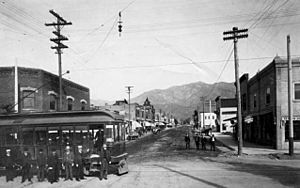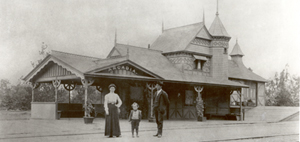Monrovia–Glendora Line facts for kids
Quick facts for kids Monrovia–Glendora |
|
|---|---|

Myrtle Avenue in Monrovia, 1903
|
|
| Overview | |
| Owner | Pacific Electric |
| Locale | Southern California |
| Termini | 6th & Main Terminal Glendora |
| Stations | 39 |
| Service | |
| Type | Interurban |
| System | Pacific Electric |
| Operator(s) | Pacific Electric |
| Rolling stock | varied |
| History | |
| Opened | 1902 |
| Closed | September 30, 1951 |
| Technical | |
| Line length | 26.21 mi (42.18 km) |
| Number of tracks | varied |
| Track gauge | 1,435 mm (4 ft 8 1⁄2 in) standard gauge |
| Electrification | 600 V DC overhead lines |
The Monrovia–Glendora Line was a special train route in Southern California. It was part of the Pacific Electric Railway, a big train system. This line helped people travel through the San Gabriel Valley. It ran for many years, from 1902 until 1951. It also helped new towns grow in the area.
A Look Back: The Line's History
The Monrovia–Glendora train line started in 1902. Passenger service began in Monrovia on March 1, 1903. The line was extended to Glendora in December 1907.
There was a plan to make the line longer by 4 miles. This extension would have gone from Glendora to Lone Hill. However, the state's Railroad Commission said no in March 1918. They said it was because of the wartime conditions.
The very last trains ran on this line on September 30, 1951.
Where the Trains Went: The Route
The Monrovia–Glendora Line started at the Pacific Electric Building in Downtown Los Angeles. This was a big station called the 6th and Main Terminal. From there, the trains shared tracks with another line, the Upland–San Bernardino Line. They traveled to a place called "Valley Junction."
After Valley Junction, the Monrovia–Glendora Line had its own tracks. These tracks ran next to Soto Street. They crossed over Valley Boulevard and the Southern Pacific Railroad tracks on a steel bridge. The line then continued north to Indian Village. Here, the tracks became a four-track system, meaning four tracks side-by-side.
A bit further north, the four tracks crossed Mission Road on a concrete bridge. They then continued between the two sides of Huntington Drive. At Sierra Vista, another line, the Alhambra–San Gabriel Line, branched off. But the Monrovia–Glendora Line kept going east on Huntington Drive.
At Oneonta Park, the Pasadena Short Line turned north. The Monrovia–Glendora Line continued with four tracks until "El Molino." There, it went back to two tracks. It kept going northeast along Huntington Drive. It passed Oak Knoll Avenue, where the Oak Knoll Line turned north. It also passed Sierra Madre Boulevard in San Marino. Here, the local Sierra Madre Line turned north.

As the line went east, it passed south of Santa Anita Park. It continued northeast to St. Joseph Street in Arcadia. The tracks ran right in the street from Santa Anita. They crossed the Atchison, Topeka and Santa Fe Railway tracks to 2nd Avenue. The Arcadia train station was a key stop. Here, passengers could switch to Santa Fe trains.
The line then went on its own tracks to Olive Avenue in Monrovia. It continued in the street on Olive Avenue to Shamrock Avenue. From there, the two tracks went on their own path along Olive Avenue and Royal Oaks Avenue. They then crossed open land to the San Gabriel River. The trains crossed the river on a two-track bridge. After 1938, this bridge was changed to a single track.
The line then continued across open land into Azusa. It entered city streets at 9th Street and Angelino Avenue. The two tracks became a single track at 9th Street and Pasadena Avenue. Finally, the line continued east, north of Foothill Boulevard, on its own path. It ended in Glendora at Glendora Avenue.
Main Stops Along the Way

